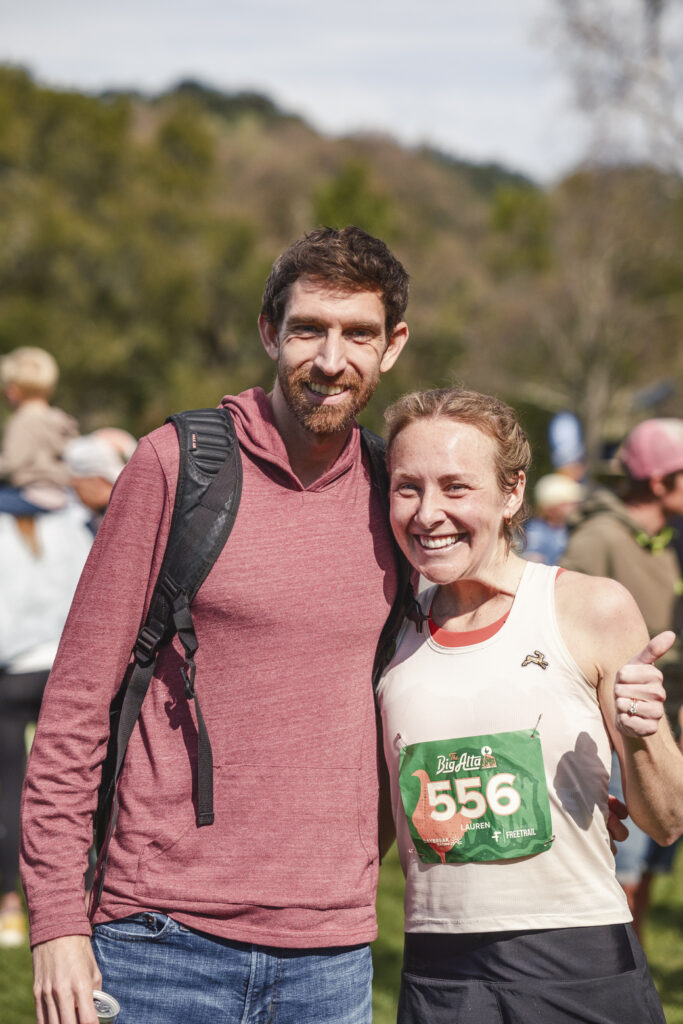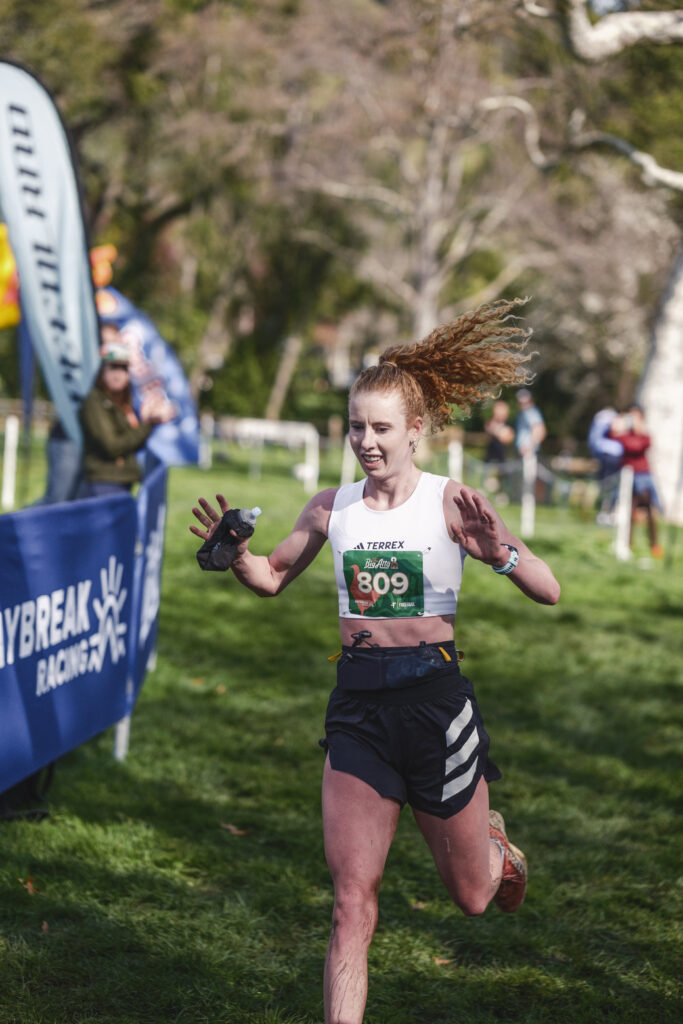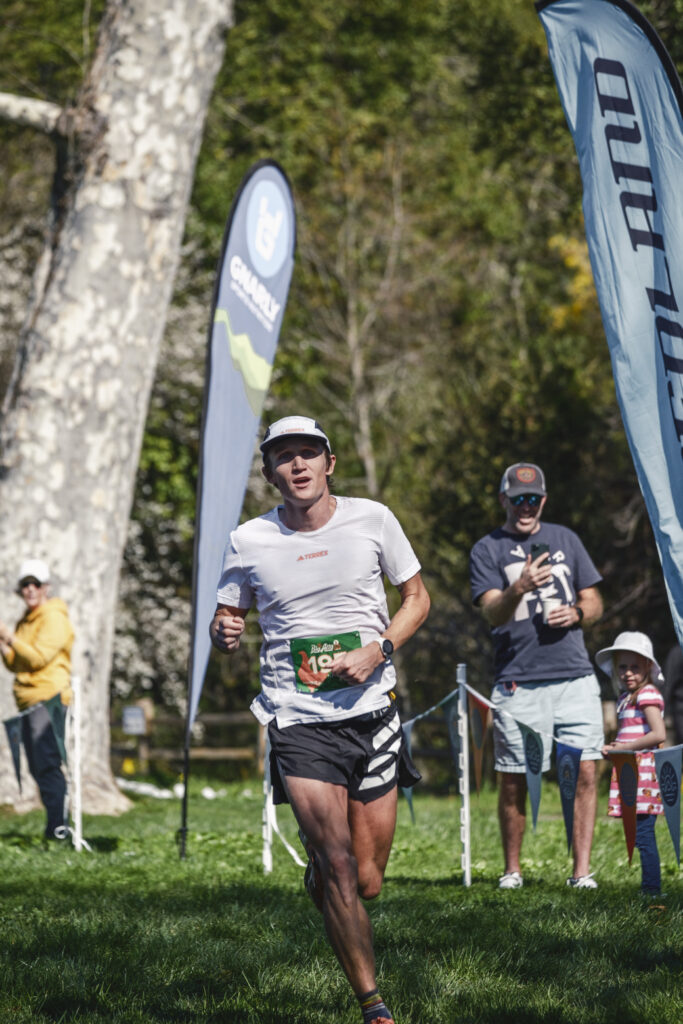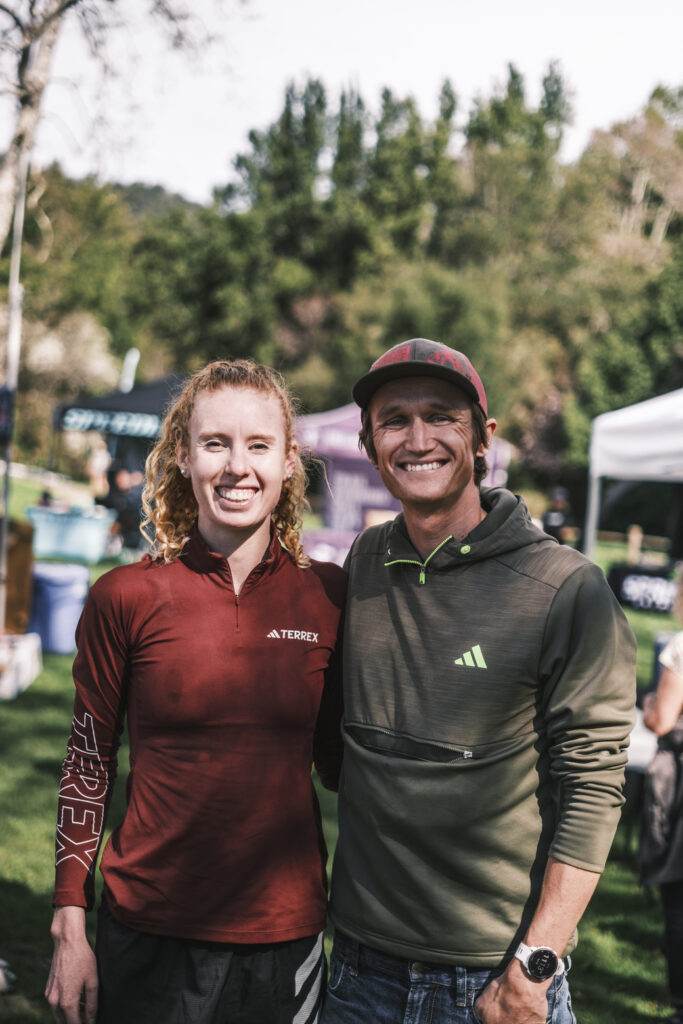In running, as in life, the greatest triumphs are those we achieve together.
If The Big Alta was scored like a cross-country race, with each couple forming their own team, Tabor and Eli Hemmings’ winning ways would’ve earned them top spot, followed by Lauren and Matt Daniels’ 9th and 3rd place finishes respectively.
Seeing the success of these power couples at The Big Alta had me curious about what it takes to combine the dynamics of a romantic relationship with the ups and downs of an athletic life, especially at the professional level where your household income depends upon continued athletic achievement.

Tabor and Eli Hemming: A package deal
I caught up with two of the most exciting rising stars in trail running, Tabor and Eli Hemming, 27 and 28 respectively, just before they left for their first Adidas Terrex team camp. Now head over heels in love with both each other and trail running, the two up-and-comers first found athletic success off the trails. Tabor was a talented track and cross country runner, with multiple All-American honors and NCAA team titles during her collegiate career at the University of Colorado, Boulder, while Eli forwent college athletics in favor of an elite triathlon career, representing Team USA on the World stage. Athletically talented individuals, the Hemmings took to the trails like fish to water, racking up podium finishes since their commitment to the sport in late 2021.
A brief look at sponsorships
For those curious about the murky world of athlete contracts and sponsorships, it might be interesting to learn that it’s common for brands to operate on a tiered sponsorship model. Newer, up-and-coming athletes, as well as those yet to race to their potential, often sign on with a company’s regional or national sponsorship program. As athletes move up the ranks, building out their race resumes, they often progress from these more local, national programs, onto the brand’s continental and global teams. While athletes sign individual contracts, each tier has its perks, athlete requirements, and level of support.
Flash back to 2023, and the Hemmings found themselves on different Salomon-sponsored teams: Eli on the global team, and Tabor part of Salomon North America. During our conversation, the Hemmings reinforced their gratitude towards Salomon, while also expressing some of the challenges of being on different teams: separate training camps, goal races, and event calendars meant they spent a lot more time apart than they wanted.
Entering into the 2024 contract-negotiation season, for Tabor and Eli, a package deal was a must.
Tabor: “When we’re talking with brands, we wanted to make sure that we were together because that’s why we got into the sport. Our previous two professional sports, triathlon and track, split us up for most of the year, so we weren’t really getting to share experiences together. And for us and our relationship, being able to share what we’re doing together is really important. So the only way we would have signed with a company was if they were willing to take us as a package deal, and Adidas gave us that opportunity.”


Training
If it wasn’t clear already, shared experiences form the cornerstone of the Hemmings’ relationship, with communication being the glue that binds it all together. In a sport that often rewards those content with solitude, Tabor and Eli provide an alternate perspective on the recipe for success, focused on experiencing the highs and lows of athletic endeavor side by side.
More than a matter of convenience, training and racing together is a conscious decision to share in the joys and challenges of competition. Add to that their decision to adopt a self-coached, experimental approach to training, and the newcomers are carving their own path to glory.
Tabor: “Our training approach works because it allows for both experimentation and then adapting on the day. If we have a huge snowstorm and we can’t get on a workout, we can easily adjust the plan for that. But mostly, we really enjoy trial and error with certain weird things in training, rather than following one coach’s training philosophy.”
Eli: “Pretty much all of our training is together, except for workouts, obviously, as we require a little bit different training and paces. Even when we do harder workouts and have different paces though, we still warm up together, do our workout, and then meet back up for the cooldown. For easy runs we’re a similar enough speed to usually go together, but if it gets super steep or super technical, and on longer runs when I want to pick up the pace, I might drop her a little bit. Then at some point I’ll turn around, run back and rejoin Tabor, we really don’t have any egos when it comes to dropping each other.”
Tabor: “We’ll always talk about it beforehand, deciding on the route and checking in with how each other is feeling and what they need out of the run. If one of us is super tired, we’ll let the other know that we’re going to totally jog today, so they have the option to jog too, or go ahead if they’re feeling good. I think that’s why it’s worked really well for us, because we’re not in the middle of the run when the other speeds up, leaving you feeling annoyed as you thought they were going to stay with you. I think a lot of tension can come by not communicating that beforehand.”
As Tabor and Eli admitted, this approach only works because they keep each other accountable and aren’t afraid to speak up when one or other crosses the line from experimental to erroneous training.
Eli: “Tabor is definitely here to rein me in, because I like doing more!”
Tabor: “No 120 mile weeks, consistently! In general, we just make sure that the other person is thinking straight as well, because I think it’s easy to get greedy with your own training.”
Race calendar and goals
The Hemmings’ 2024 race calendar also reflects their desire to create memories together on the trails, both eyeing UTMB’s 55-kilometer race, OCC, taking place in late August.
Tabor: “This year works out really well because we both have the same goal: OCC. We just want to stay healthy and be ready to both have really good races there, and right now it’s nice to step out the door and work towards the same collective goal. In the coming years, it might be a bit more challenging as our races diverge more, but we’ll still be there as that cheerleader to one-another.”
As Tabor hinted at, for all their similarities and shared passions, the pair aren’t shy about their differing athletic ambitions. And even this year as both Tabor and Eli shoot for the same goal race, their paths to OCC look different, with Eli stepping up to some longer races while Tabor hones her speed on sub-ultra distances.
Tabor: “Black Canyon was a good example of that: we knew it was going to be a good 60k for Eli, but I certainly wasn’t going to race that long. And it just so happened that I was able to race a nearby half marathon on the roads that weekend. But if that hadn’t matched up, I would have spectated anyways. As Eli looks to dabble in some of the longer stuff going forward, while I stick to races under 60km, we’ll still go together, we’re not gonna travel separately.”
Eli: “The Big Alta was similar: initially we were both signed up for the 50km on Saturday, but then Tabor dropped down to the 28km on Sunday, so we were there to support each others’ races.”
One detail the pair forgot to mention was how successful the aforementioned weekends were for them: Eli dominated both Black Canyons 60km and The Big Alta 50km races, winning both in course record times, while Tabor clocked a phenomenal 1:13 half marathon, before winning The Big Alta 28km, also setting a course record.

Often racing the same events, or different events on the same weekend, I was curious about the impact of any pre-race anxiety on their relationship.
Eli: “A lot of times, I’m more nervous for her than I am for me.”
Tabor: “But I think collectively, we’re less nervous because we’re together, we have each other. It’s like if you’ve ever been on a college or high school team, and you’re all collectively nervous, but it feels more comfortable knowing that everyone’s doing this with you, rather than just being by yourself and wondering if you’re the only one feeling really nervous.”
Maintaining a romantic relationship with training and self-coaching
Much like those in traditional 9-5 jobs are advised to leave work at the office door rather than taking it home with them, the Hemmings share a similar perspective, rarely talking about running outside of training, despite being self-coached athletes. Stride for stride, they are deep in discussion about training philosophy, workout designs, race plans, and more – once the run is done, their topic of conversation shifts.
Tabor: “We make sure to definitely separate running from the rest of our lives: most of our training talks are during training, even if we’re coming up with new ideas of random things to try in training, it’s usually on an easy run or ride.”
“I think it helps that we pack our schedules really full; once we’re done with training, we’re moving on to so many other things in the day, we don’t really have time to just sit and ruminate about our runs.”
Not your typical professional runners spending hours on the couch watching Netflix or napping, the Hemmings take a less conventional approach to filling their non-running hours.
Tabor: “As well as our coaching business and other non-running relationships with friends and family, we have our chores on the ranch.”
Yep, that’s right, the Hemmings live on Tabor’s family’s working ranch, raising livestock and caring for the animals year round!
Tabor: “We usually keep around 200 head of cattle all year round, except for calving season coming up next month, when the herd will double. We’ll have about 400 cows on the ranch through the spring and summer, plus our dogs.”
I guess that’s one way of accumulating time on feet and strength training!
Tabor: “It hardens you for sure, so that when you get to a race, you’re like, wow, I feel so fresh, this is amazing!”
Eli: “Taper weeks are the best thing when we travel for them, because we can’t do any of what we usually do. Our minds are so at ease, everything’s great! Going into this training camp. I actually bought a fictional book, and I’m so excited to sit by the pool and actually read!”
Dealing with highs and lows
As many of us can appreciate, communication is easy when things are going well, unfortunately, an athletic life isn’t always a smooth ride. But the highs are only sweet because of the lows, maintaining that perspective through setbacks seems all the more challenging if the person you spend every waking moment with is running through a purple patch of success. It’s easy to imagine resentment or envy might cause a rift in the relationship, but yet again, the Hemmings show incredible maturity for a couple so young.
Eli: “We’ve both had injuries, Tabor definitely more so than me. Through setbacks, it really goes back to how we are moving towards a big picture goal, rather than overfocusing on the next race. We are always trying to get better at the sport, so if one of us can’t run, it’s focusing on what the next best thing is, and sometimes that is hopping on a bike for six weeks.”
Tabor: “I think the other person is really good at modifying their training to support the injured one, and that’s another reason why it’s nice to be self coached. Say, for instance, I was injured and I had to be on the bike, Eli would switch some of his doubles or even his run days to a bike with me, because he knows how lonely that is. And if he had a run workout, I’d be on the bike next to him, helping him with that. It goes both ways: the other person tries to be as supportive to the injured person as possible, but also the injured person understands how lonely it is to do workouts alone, so is supportive too.”
“Our love language is definitely time spent together, and that’s really the foundation of our relationship, alongside communication. So even if one person can’t be running, we’re still trying to spend as much time out in the world with them as much as possible.”
Given injuries and running lulls don’t seem to present themselves as challenges to the Hemmings’ relationship, I thought I’d get down to some hard-hitting journalism and explicitly ask them about the good, the bad, and the ugly.
Eli: “Most people don’t believe us, but we don’t fight very much. We have disagreements, for sure, but we talk everything through and it seems to work out pretty well. As with everything that we do, it just goes back to communication.”

Eli summed up this article and the Hemmings’ successful partnership better than I could: “It just goes back to communication”, a reminder we can all take into our relationships on the run and beyond. Whether it’s while training or working the ranch, managing household chores, or their coaching business, Tabor and Eli aren’t pretending when they say time spent together is their love language. As cheesy as it sounds, or reads, the pair seem like a match made in heaven, and despite on the surface running being an individual sport, this performance-enhancing partnership serves as a testament to the power of unity and collaboration. Not to mention the reality that in running, as in life, the greatest triumphs are those we achieve together.
Follow the Hemmings on their path to OCC through their new YouTube channel as well as on social media. Catch them racing next on April 27th, at The Canyons Endurance Runs 50km race, where they’re sure to make their presence known. Before that, you’ll find Tabor and Eli swimming in pools of sweat, deep in heat training.
